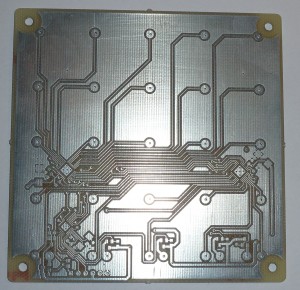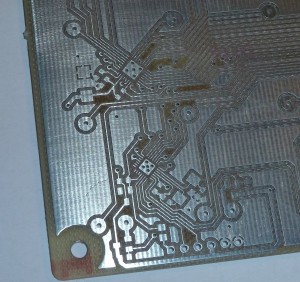I’m in the process of building a 5x5x5 LED Cube like many others. The firmware is designed by [SiGNOUT] and [knielsen] from the local Hackerspace.
Their Cubes use a Seperate Arduino, and TLC5940 LED-drivers in TSOP housing. I would like to push the limits on my version of it, so i ordered the TLC5940 and Atmega328P in the smallest possible cases available. I would like to try BGA some day, but BGA requires more than dual layer PCB, so that’s impossible without professional PCB’s. The Atmel is 4mm² and the TLC5940 is 5mm².
The board is 2-layer and has holes through plated chemically. It is made on our Protomat & Minicontac II.
Here’s some pictures of the milled PCB:
Some more pictures in the Gallery
There’s pictures of another PCB in the folder, an Infrared LED exposure device for Playing with a Laser printer.


March 23rd, 2013 at 16:14
[…] out this milled PCB that Per from Zapro.dk Blog has made. If you think those are small traces and fine work for a […]
March 23rd, 2013 at 16:35
[…] out this milled PCB that Per from Zapro.dk Blog has made. If you think those are small traces and fine work for a […]
March 23rd, 2013 at 16:45
[…] out this milled PCB that Per from Zapro.dk Blog has made. If you think …Read More **PLEASE SHARE** source: […]
March 23rd, 2013 at 17:20
[…] out this milled PCB that Per from Zapro.dk […]
March 24th, 2013 at 07:08
[…] out this milled PCB that Per from Zapro.dk Blog has made. If you think those are small traces and fine work for a […]
March 24th, 2013 at 17:30
Is Minicontac the plating device? Apparently, it does a great job, and so does the milling machine, the result looks very nice and clean!
March 24th, 2013 at 18:44
The MiniContac II is a electrochemical plating system yes. The milling machine is able to do 4 mil details, but we only have tools for 8 mil, since the smaller ones is too expensive and wears out really fast.
March 24th, 2013 at 20:07
8 mil is safe for most PCB board houses, and 4 mil may not be, so I imagine there’s no reason to push the machine to its limit for prototyping if you won’t be able to make actual boards (economically) with the same accuracy. Also, I imagine milling it to 4 mil accuracy would take 2-4 times longer?
Just out of curiosity, how long did it take it to mill out the LED cube PCB pictured here? Do you remember the spindle RPM and the feed rate values? Thanks!
March 24th, 2013 at 20:38
Yep, no real need to go to 4 mils, since 8 mils is small enough for the smallest component we can mount by hand anyway.
Milling of the board took around 30 mins, and chemical trough-hole plating 2 hours. The spindle runs at 40.000 or 60.000 RPM when milling small features, i don’t recall which i used. I have no idea about the feedrate, it’s all standard settings in the software for the machine.
March 24th, 2013 at 21:40
Ah, 40,000 RPM – that’s where the key to that awesome quality is! I am trying to squeeze every last bit of speed from my CNC router’s spindle but I have no hope of ever exceeding 10,000 RPMs – my guess is that’s what makes the edges of the traces so jagged. Is it pressure air turbine or a BLDC motor, do you know?
Thanks again for the photos – I may never be able to achieve the quality on my equipment but it’s a great reminder of what can be done, so I’ll just keep trying.
Cheers!
March 24th, 2013 at 21:49
Yep. It’s the high RPM that makes it possible to do such fine milling. The motor is a BLDC.